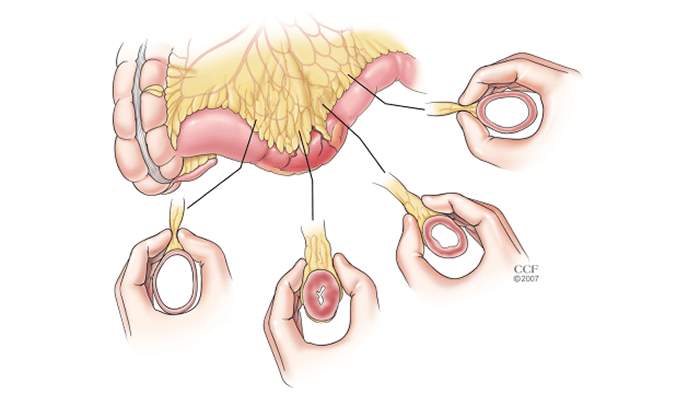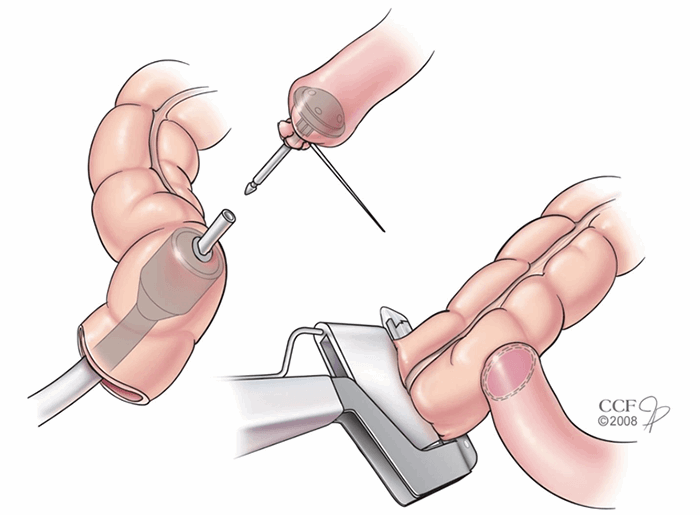Discussion
Childhood-onset Crohn disease (CD) is characterized by widespread extent, complications with early corticosteroid dependence, and need for surgical intervention in nearly half of patients by the age of 30 compared with 14 percent in adult-onset disease.1 The incidence of CD in children and adolescents is increasing, with an incidence of 2.5 to 11.4 per 100,000 and a prevalence of 58 per 100,000.2,3 The characteristics of Crohn lesions along the gastrointestinal tract in children and adolescents is similar to those in adult-onset disease. In a large cohort of European children with CD, ileocolonic disease was found in 53 percent of the patients, followed by isolated colonic disease (27 percent) and limited cecal disease (16 percent).4 The mainstay treatment, as with adult-onset CD, involves anti-inflammatory agents, biologics, and immunosuppressants with surgical interventions for complications including fistulas, strictures, abscesses, or medically-refractory disease.5 Careful selection of medical and surgical interventions are necessary given the high rates of complications and increased likelihood of repeat surgeries in the management of pediatric CD. Treatment priorities are given special consideration to pediatric patients compared to adults given their potential for growth and development.
This current case of CD presenting with an entero-urachal abscess from fistulizing disease of the terminal ileum with subsequent fistulization through the abdominal wall and patent urachus in a pediatric patient is unusual because the majority of Crohn fistulae are internal, most significantly entero-colonic, while external pathology (such as entero-cutaneous and entero-vaginal fistulae) are less common.6 Only three cases of entero-uracho-cutaneous fistula in pediatric CD patients have been reported to date.7-9 Previous reports advocated for en bloc resection of the fistulous segment and the bladder dome in diseases involving the bladder and manifesting with urinary symptoms.10 In this patient, the involvement of the urachus was limited to the segment near the umbilicus, sparing the bladder and the need for more extensive surgery, including complete resection of the urachus. Consideration was given to fully excising the urachus. This was considered to be unnecessary, though, as the fistula tract had never communication with the bladder. Also, on dividing the urachus, no open communication to the bladder was identified, suggesting this segment was obliterated.
This case also demonstrates the use of preoperative medical management of inflammation in a complicated fistula, especially the use of a low-dose corticosteroid regimen in the perioperative setting instead of the stress-dose regimen. Recent studies demonstrated minimal difference in outcome for inflammatory bowel disease patients receiving high-dose, low-dose, or no perioperative corticosteroids as well as a lack of advantage to stress dose corticosteroids.11,12 Thus, surgeons are shifting from the use of stress-dose corticosteroids, but practice patterns remain highly variable. In general, the use of steroids in children should be given special consideration due to their growth restricting effects, but they remain useful in the pre- and peri-operative setting in combination with antibiotics for decreasing complication risk.
Conclusion
Childhood-onset Crohn disease is associated with an increased prevalence of complications requiring surgical intervention. The authors highlighted the surgical management of a complex fistula presenting in pediatric Crohn disease and the beneficial role of low-dose corticosteroids in the preoperative period.
Lessons Learned
Childhood-onset Crohn disease is associated with an increased likelihood of requiring surgical intervention. The majority of Crohn fistulae are internal, most significantly entero-colonic, while external pathology (such as entero-cutaneous and entero-vaginal fistulae) are less common. Only three cases of entero-uracho-cutaneous fistula in pediatric CD patients have been reported to date. Surgical approaches in this unique setting may thus shift slightly from more standard techniques. In this setting, there is also a role for low-dose corticosteroids in the preoperative period instead of the use of a stress-dose regimen.
Authors
Authors
Kang L; Mubashir M; Schwartzberg D; Lipman JM
Corresponding Author
Jeremy M. Lipman, MD, MHPE
Department of Colorectal Surgery
9500 Euclid Avenue
Cleveland, OH 44195
Phone: (216) 444-4093
E-mail: lipmanj@ccf.org
Author Affiliation
Cleveland Clinic Foundation
Department of Colorectal Surgery
Cleveland, OH 44195
Disclosure Statement
The authors have no conflicts of interest to disclose.
References
- Ruemmele FM, Veres G, Kolho KL, et al. Consensus guidelines of ECCO/ESPGHAN on the medical management of pediatric Crohn disease. J Crohns Colitis. 2014;8(10):1179-1207. doi:10.1016/j.crohns.2014.04.005
- Kappelman MD, Rifas-Shiman SL, Kleinman K, et al. The prevalence and geographic distribution of Crohn disease and ulcerative colitis in the United States. Clin Gastroenterol Hepatol. 2007;5(12):1424-1429. doi:10.1016/j.cgh.2007.07.012
- Benchimol EI, Fortinsky KJ, Gozdyra P, Van den Heuvel M, Van Limbergen J, Griffiths AM. Epidemiology of pediatric inflammatory bowel disease: a systematic review of international trends. Inflamm Bowel Dis. 2011;17(1):423-439. doi:10.1002/ibd.21349
- de Bie CI, Paerregaard A, Kolacek S, et al. Disease phenotype at diagnosis in pediatric Crohn disease: 5-year analyses of the EUROKIDS Registry. Inflamm Bowel Dis. 2013;19(2):378-385. doi:10.1002/ibd.23008
- von Allmen D. Pediatric Crohn Disease. Clin Colon Rectal Surg. 2018;31(2):80-88. doi:10.1055/s-0037-1609022
- Michelassi F, Stella M, Balestracci T, Giuliante F, Marogna P, Block GE. Incidence, diagnosis, and treatment of enteric and colorectal fistulae in patients with Crohn disease. Ann Surg. 1993;218(5):660-666. doi:10.1097/00000658-199321850-00012
- Mador BD, Blair GK. Pediatric Crohn disease complicated by an entero-uracho-cutaneous fistula. J Ped Surg Case Reports. 2014;2:79-81. doi:10.1016/j.epsc.2014.01.006
- Keir JA, McGregor R, Richards CJ, Windle R. An unusual presentation of Crohn disease. Ann R Coll Surg Engl. 2004;86(6):W22-W23. doi:10.1308/147870804137
- Hollander LL, Girard ED, Ruscher KA, Sayej W, Kim C, Finck CM. Infected urachal cyst secondary to a Crohn enterourachal fistula. J Pediatr Surg. 2012;47(12):e43-e46. doi:10.1016/j.jpedsurg.2012.09.041
- Tsukui H, Koinuma K, Morimoto M, et al. Crohn disease presenting as a ceco-urachal fistula. Clin J Gastroenterol. 2017;10(1):32-36. doi:10.1007/s12328-016-0691-2
- Zaghiyan K, Melmed GY, Berel D, Ovsepyan G, Murrell Z, Fleshner P. A prospective, randomized, noninferiority trial of steroid dosing after major colorectal surgery. Ann Surg. 2014;259(1):32-37. doi:10.1097/SLA.0b013e318297adca
- Zaghiyan K, Melmed G, Murrell Z, Fleshner P. Safety and feasibility of using low-dose perioperative intravenous steroids in inflammatory bowel disease patients undergoing major colorectal surgery: A pilot study. Surgery. 2012;152(2):158-163. doi:10.1016/j.surg.2012.02.019




